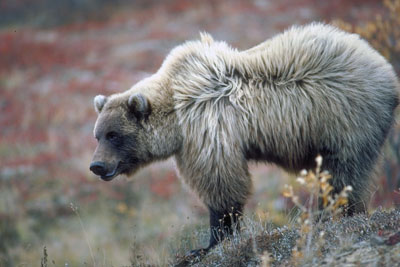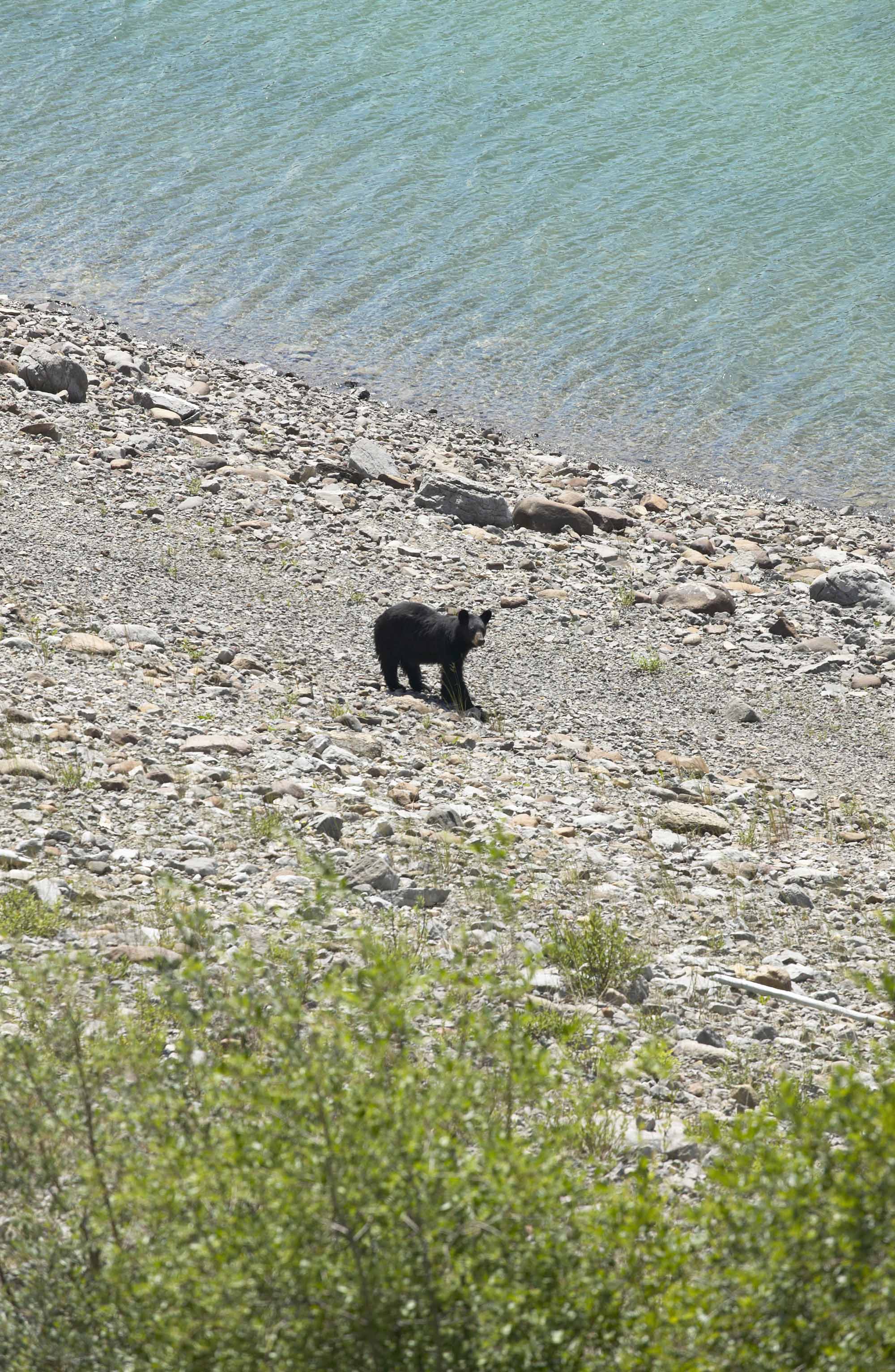The grizzly bear (Ursus arctos horribilis) is a large mammal of the order Carnivora. Grizzly bears are a subspecies of brown bear that lives in North America, with distinct regional populations ranging across western Canada. They are the second largest land carnivore in North America.
Description
Grizzlies can be distinguished from other bears in Canada by the large hump on their back and their dish-shaped facial structure. They also have longer front claws and are larger than black bears. Large males may weigh 250–400 kg; large females, 150–200 kg. While primarily brown, their colouration ranges from black to blond. The ends of their fur on the flanks, back and shoulders are often grizzled (i.e., have white or grey flecks).
Distribution and Habitat
Grizzlies prefer semi-open habitats like grasslands. An adult male may have a home range as extensive as 6,700 km when living in the tundra. Females typically have smaller ranges as their smaller size makes them need less food and they do not need to travel to find mates. As human populations have expanded, grizzly bear numbers have declined. By about 1900, the grizzly population had gone locally extinct in the prairies. As of 2012, three-quarters of Canada's 27,000 to 29,000 grizzly bears are found in B.C. and the Yukon. There are also grizzly populations in Alberta, the Northwest Territories and Nunavut. With climate change, their range has also been slowly expanding northward.
The grizzly is considered a species of special concern in Canada by the Committee on the Status of Endangered Wildlife in Canada, meaning that, without further action, they are at risk of becoming threatened and potentially even endangered. Loss of habitat and habitat fragmentation (usually due to human activity) are the greatest risks to grizzly bear numbers.
Diet
The grizzly bear differs from other North American carnivores in that it eats primarily plant matter. Up to 90 per cent of a grizzly bear’s diet may be nuts, grasses, roots and berries. Grizzlies will opportunistically kill or scavenge animals, especially moose, deer, ground squirrels and insects. Coastal populations feed heavily on fish and shellfish. Large amounts of bears have been known to congregate around salmon-rich streams. They are also attracted to edible garbage.
By fall, they must store sufficient fat to begin a 4–7 month dormant period in their dens during which they usually do not eat, urinate or defecate. During this time, their heart rate may drop from 40-50 beats per minute to only 8–10 beats per minute. Their body temperature may also lower to about 4–5oC. This allows them to retain enough energy to survive the winter months without eating. By the end of the winter, males will lose up to 25 per cent of their weight, while lactating females may lose as much as 40 per cent of their weight.
Reproduction and Development
Typically solitary, courtship is one of the few times adult grizzlies will be in close proximity to each other. Females will be fertile for 10–30 days, sometime between mid-May and early July. During this time, multiple males may follow her and become aggressive with one another to secure the right to mate with her. Following fertilization, embryo implantation is usually delayed until fall. In delayed implantation, the embryo develops slowly while floating in the uterus. Eventually, it becomes attached to the wall of the uterus, and development continues normally until birth.
Young are born in January and February. Newborns weigh about 0.5 kg and are nursed inside dens for up to 3 months. Litters average 2 cubs (range 1–4) who often stay with their mothers for 2–3 years. It will typically take 4.5 years for young bears to reach sexual maturity. Additionally, females only breed once every 3 years (range 2–5 years). Grizzlies thus have few young, and hunting must be carefully regulated to maintain a healthy bear population. In the wild, most die before reaching adulthood; 15–25 years is considered old.
Behaviour
Grizzly bears are known for standing their ground. Mothers may defend their young, and males may fight, especially during the breeding season. Occasionally, aggression is directed toward humans: in Canada's National Parks, about 1 visitor in 2 million is injured by a grizzly. However, most negative human-grizzly interactions are territorial, not predatory. Taking appropriate measures, such as proper food and trash storage, when in bear habitat can help keep both humans and grizzly bears safe. Grizzlies may stand on their hind legs when sensing their environment. They typically charge on four legs and can run at least 50 km/h.
Relationship with Indigenous Peoples
Many Indigenous Nations in Western Canada hold grizzly bears in high regard and have a long history of respect for these bears. To this day, Indigenous people, grizzly bears, and salmon share an ancient and enduring connection, as people and bears both rely upon salmon populations for food. Indigenous people, such as the Heiltsuk Nation, are currently an important component of successful bear conservation practices.

 Share on Facebook
Share on Facebook Share on X
Share on X Share by Email
Share by Email Share on Google Classroom
Share on Google Classroom













